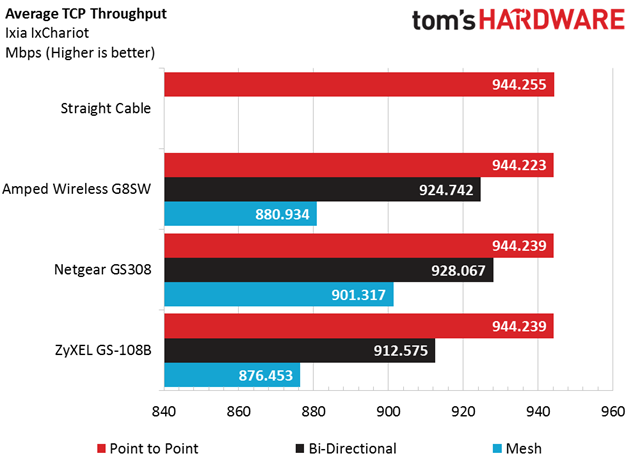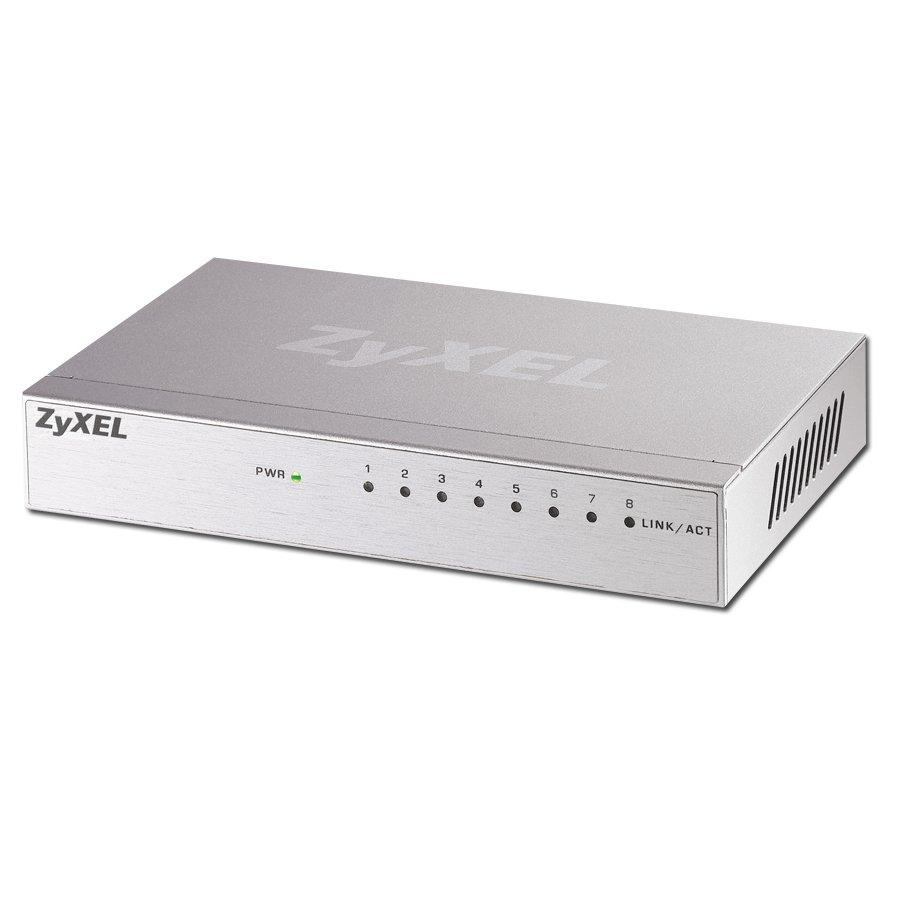Unmanaged Gigabit Ethernet Switch Round-Up
We rounded up unmanaged gigabit Ethernet switches from Netgear, Amped Wireless and ZyXEL to see which one deserves a thumbs up.
Test Results
Why you can trust Tom's Hardware
We collected four types of benchmark results in ixChariot: straight cable, point-to-point, bi-directional and mesh. The straight cable results were gathered by connecting the server and client to each other with a patch cable, thus excluding a switch. Point-to-point results were generated by connecting the server and client to each switch and passing information from the server to the client. Bi-directional testing involved connecting the server and client to the switch, and passing data between both at the same time. Mesh testing results came from running the point-to-point test, while also adding three other machines that simultaneously generate traffic to saturate the switch.
In theory, a 1Gb/s connection should be able to move 1 Gb/s. In the real world, however, hardware, software and environmental variables limit maximum performance. A straight cable naturally performs best since there's nothing in the middle to affect the results.
Once you add a switch the mix, you see that Netgear's GS308 beats out the competition in most disciplines. Amped's G8SW takes second place, most notably posting lower mesh and bi-directional results.
Our numbers demonstrate minimal differences between the three switches, except when you get to the mesh metric. Even then, you wouldn't notice that delta in a real-world setting.
Despite fairly consistent response times across all three switches, the Netgear GS308 switch technically take first place. Amped Wireless' G8SW posts a good result as well, but cannot match Netgear's GS308 or ZyXEL's GS-108B.
Get Tom's Hardware's best news and in-depth reviews, straight to your inbox.
-
dealcorn Gigabyte ethernet switches often run 24/7. Power consumption data should have been measured.Reply -
Aslan7 Useful info to have, but there's a lot more switches out there than this. 8 port switches are only big enough for the living room.Reply
TV
Blueray player
2 consoles
Streaming media player
Audio amplifier
Home theater PC
8 port barely does it for the living room. We need some reviews of 16 and 24 port gigabit switches for the home, plus I'm sick and tired of gigabit and want 10GBE already, but all of the equipment seems horrifically expensive or has flaky drivers.
What' is good in 10GBE both adapters and switches? -
CaedenV ReplyUseful info to have, but there's a lot more switches out there than this. 8 port switches are only big enough for the living room.
For 16 and 24 port switches you are going to find the same: Netgear is so far beyond the competition, and so much cheaper than anything out there, that is amazes me that anyone else makes cheap unmanaged switches. Unless you need a cheap managed switch, there just are not any other real options on the market.
TV
Blueray player
2 consoles
Streaming media player
Audio amplifier
Home theater PC
8 port barely does it for the living room. We need some reviews of 16 and 24 port gigabit switches for the home, plus I'm sick and tired of gigabit and want 10GBE already, but all of the equipment seems horrifically expensive or has flaky drivers.
What' is good in 10GBE both adapters and switches?
For 10GbE switches, as far as I can tell there aren't any good cheap consumer items on the market yet. There is a flood of 'cheap' used profesional equipment available... but even then you are looking at $1-200 per adapter, and ~$1K for a switch, and typically not in great condition... and because it is pro equipment you have to do a bit of research to get it working properly.
10GbE 'is coming' but I think we are still a few years out from seeing normal consumer 'plug and play' equipment, and a few more years before it becomes affordable. -
Onus This makes me glad I chose a Netgear switch for my motherboard LAN adapter throughput testing. The differences are very small, but might make a difference.Reply
-
Rookie_MIB Right now you can get 10GbE adapters for your computer for a reasonable price for used equipment ($20-$50), it really is the switches which are ridiculous. Overall though for the most part, it's only some fringe use cases where a home user might need 10GbE ethernet.Reply
First - unless you have some insane connection to the outside world, the most you can really get right now as far as internet speeds is 1Gb anyhow. That becomes your choke point.
Next, overall, video is the most demanding when it comes to traffic, and the average bitrate requirement for 4k streaming comes in somewhere around 15Mbit. Doing the math, that means an average 1Gbit connection could support about 60 concurrent streams. Your average home WON'T be doing that. Honestly, a small apartment complex wouldn't even hit that.
Now, who knows what the future will bring, perhaps some killer app might require that kind of bandwidth, but right now it's not here for the majority of the people. That doesn't mean that we should stop developing and investing in increased bandwidth, but right now 10GbE is a bit over the top for a home network. -
SirGCal Reply17330928 said:Useful info to have, but there's a lot more switches out there than this. 8 port switches are only big enough for the living room.
8 port barely does it for the living room. We need some reviews of 16 and 24 port gigabit switches for the home, plus I'm sick and tired of gigabit and want 10GBE already, but all of the equipment seems horrifically expensive or has flaky drivers.
What' is good in 10GBE both adapters and switches?
I agree. I personally went with a Cisco SG100-16 for only $109 at the time (Amazon), but it hasn't changed much either. Up now, down later, etc. Like everything on the net.
I do have some 10G gear myself but it's easier just to do some port ganging, teaming or aggregation. But that requires a different switch yet again. Wee... But then also you'd burn through ports faster. -
InvalidError How is the lack of heatsink a 'con' when there is no significant heat even without one? If no heatsink is necessary to keep temperatures reasonable, putting a heatsink in is just a waste of material and an unnecessary cost since it won't improve performance or reliability in any way.Reply -
tsnor (1) Good test. Really nice to see data confirming we should just buy whatever switch is on sale.Reply
(2) would have been nice to see a large file transfer done 3 times using one switch to get the variance and then done for all switches just to confirm that the micro benchmarks (which say we won't see a difference) are accurate.
(2) I did not see what was measured for response time. Maybe I missed it. Interesting to note most SSDs can deliver 4K of data in roughly the same time as the measured 'response time' -
nukemaster ReplyHow is the lack of heatsink a 'con' when there is no significant heat even without one? If no heatsink is necessary to keep temperatures reasonable, putting a heatsink in is just a waste of material and an unnecessary cost since it won't improve performance or reliability in any way.
People like heatsinks :)
-
firefoxx04 Would love to see power consumption. I just purchased a TP-LINK TL-SG108 8-Port and could not be happier. I was very skeptical of the cost but it runs great. I still max out my gigabit cards at 100-120MB/s. Power consumption is VERY low and the switch itself is tiny. Very happy for $25 with prime shipping.Reply




